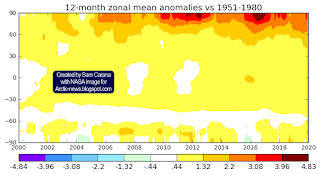The NASA image below shows the March 2022 temperature anomaly. The Arctic is heating up strongly.
The above image shows a temperature rise for March 2022 of 1.06°C, which is the rise from 1951-1980. The image below shows a temperature rise from 1900 for March 2022 of 1.36°C.
 |
| [ click on images to enlarge ] |
Note that the March 2022 temperature is suppressed, as we're currently in the depth of a persistent La Niña, as illustrated by the NOAA image on the right.
 |
| [ click on images to enlarge ] |
The above NOAA image shows that the difference between the top of El Niño and the bottom of La Niña could be more than half a degree Celsius. The peak of the next El Niño may well coincide with a high number of sunspots (NOAA image right).
The image below features two trends. The black trend is based on adjusted Jan.1880-Mar.2022 NASA data and shows how 3°C could be crossed in 2027. The blue trend is based on adjusted Apr.2012-Mar.2022 NASA data and better reflects short-term variables such as sunspots and El Niño. The blue trend shows how 3°C could be crossed in 2025, triggered by an emerging El Niño and high sunspots.
 |
| [ click on images to enlarge ] |
Moreover, this could trigger runaway temperature rise, starting before 2026 where the temperature rise is felt most strongly, i.e. in the Arctic, especially during El Niño events, as illustrated by the image on the right that shows anomalies (vs 1951-1980) as high as 6.6°C in the Arctic.
 |
| [ see the Extinction page ] |
As temperatures rise, loss of Arctic sea ice and of its latent heat buffer will cause more heating of the atmosphere, while changes to the Jet Stream will cause more extreme weather.
As humans go extinct, transport and industrial activities will stop that currently co-emit sulfur that masks the full extent of the temperature rise.
In addition, as also discussed at the aerosols page, worldwide forest fires and trash fires could cause huge amounts of black carbon to be emitted.
Rising temperatures will result in more water vapor in the atmosphere (7% more water vapor for every 1°C warming), further amplifying the temperature rise, since water vapor is a potent greenhouse gas.
As the IPCC warns (see above image), for each additional 1°C of warming, the global volume of perennially frozen ground to 3 m below the surface is projected to decrease by about 25% relative to the present volume, and the IPCC adds that these decreases may be underestimates. As permafrost declines, huge amounts of carbon dioxide, methane and nitrous oxide get released.
As the ocean heats up, a huge temperature rise could be caused by releases of seafloor methane, further contributing to the clouds tipping point (at 1200 ppm CO₂e) to get crossed, causing a further rise of 8°C. Altogether, the temperature rise could exceed 18°C.
The situation is dire and calls for comprehensive and effective action, as described in the Climate Plan.
In the video below, Jennifer Hynes and Sandy Schoelles discuss the temperature rise.
Links
• NASA Gistemp
https://data.giss.nasa.gov/gistemp
• Pre-industrial
https://arctic-news.blogspot.com/p/pre-industrial.html
• When Will We Die?
https://arctic-news.blogspot.com/2019/06/when-will-we-die.html
• NOAA - Monthly Temperature Anomalies Versus El Niño
https://www.ncei.noaa.gov/access/monitoring/monthly-report/global/202203/supplemental/page-4
• NOAA - ENSO: Recent Evolution, Current Status and Predictions
https://www.cpc.ncep.noaa.gov/products/analysis_monitoring/lanina/enso_evolution-status-fcsts-web.pdf
• NOAA - Solar cycle sunspots progression
https://www.swpc.noaa.gov/products/solar-cycle-progression
• Sunspots
https://arctic-news.blogspot.com/p/sunspots.html
• Extinction
https://arctic-news.blogspot.com/p/extinction.html
• Aerosols
https://arctic-news.blogspot.com/p/aerosols.html
• Arctic Hit By Ten Tipping Points
https://arctic-news.blogspot.com/2020/04/arctic-hit-by-ten-tipping-points.html
• IPCC - FAQ on water vapor
https://wg1.ipcc.ch/publications/wg1-ar4/faq/wg1_faq-3.2.html
• IPCC - AR6 WG1 TS on permafrost
https://www.ipcc.ch/report/ar6/wg1/downloads/report/IPCC_AR6_WGI_TS.pdf
• Clouds feedback
https://arctic-news.blogspot.com/p/clouds-feedback.html
• Climate Plan
https://arctic-news.blogspot.com/p/climateplan.html












![[ click on images to enlarge ]](https://blogger.googleusercontent.com/img/b/R29vZ2xl/AVvXsEjBULCiq_2Euddl4zoTQ29dVdWCHG5ubjXQ3e8BMvWAbzOr8KIa8vFDh93RkPCtxgr0tpVNjvH5lTvVVQ-6u8Bbww3gXVitUgmhcvvg8cpujuD_fhE9Tqt8nLvJ3UjYZtEntWhyphenhyphenTPhhpCs/w640-h272/August-2020-NH-OTA-narrow.png)



























